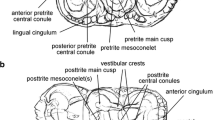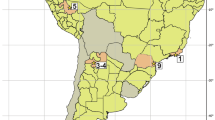Abstract
The diversity of South American proboscideans during the Quaternary has been a subject of discussion for decades. The presence of Cuvieronius hyodon in South America is unquestioned and unanimous; however, the taxonomy of the known second South American proboscidean is still a controversy. Some authors argue that the South American species traditionally referred to Stegomastodon should instead be referred to a distinc genus, namely Notiomastodon, endemic to South America. Others authors, however, do not accept this attribution and continue to recognize the genus Stegomastodon as present in South America. In this study, we recognize several differences in the mandible, skull, dentition, and postcranial morphology of North American species of Stegomastodon and Notiomastodon, that further support the validity of Notiomastodon as a taxon separate from Stegomastodon. Indeed, a phylogenetic hypothesis of trilophodont bunodont proboscideans supports the separation between Stegomastodon and Notiomastodon, and the diversification of the common ancestor of these proboscideans may have occurred during the middle to late Miocene. No specimen with Stegomastodon diagnostic features is recognized in South America. The Stegomastodon records are restricted to the Pliocene-middle Pleistocene of North America, while Notiomastodon records are found only from the middle Pleistocene-early Holocene of South America. In this way, we recognize that Stegomastodon records are restricted to North America and that only Cuvieronius and Notiomastodon are recorded in South America.




Similar content being viewed by others
References
Alberdi MT, Cartelle C, Prado JL (2002) El registro de Stegomastodon (Mammalia, Gomphotheriidae) en el Pleistoceno superior de Brasil. Rev Esp Paleontol 17(2):217–235
Alberdi MT, Juárez-Woo J, Polaco OJ, Arroyo-Cabrales J (2009) Description of the most complete skeleton of Stegomastodon (Mammalia, Gomphotheriidae) recorded for the Mexican late Pleistocene. Neues Jahrb Geol Paläontol Abh 251:239–255
Alberdi MT, Prado JL (1995) Los mastodontes de América del Sur. In: Alberdi MT, Leone G, Tonni EP (eds) Evolución biológica y climática de la Región Pampeana durante los últimos 5 millones de años. Un ensayo de correlación con el Mediterráneo occidental. Monog Mus Nac Cienc Nat, CSIC, España, pp 277–292
Alberdi MT, Prado JL (2016) Fossil Gomphotheriidae from Argentina. In: Agnolin FL, Lio GL, Brisson-Egli F, Chimento NR, Novas FE (eds) Historia Evolutiva y Paleobiogeográfica de los Vertebrados de América del Sur. Contribuciones del MACN, Buenos Aires, Argentina, pp 275–283
Alberdi MT, Prado JL, Ortiz-Jaureguizar E, Posadas P, Donato M (2007) Historical biogeography of trilophodont gomphotheres (Mammalia, Proboscidea) reconstructed applying dispersion vicariance analysis. Cuad Mus Geomin 8:9–14
Alberdi MT, Prado JL, Salas R (2004) The Pleistocene Gomphotheriidae (Proboscidea) from Peru. Neues Jahrb Geol Paläontol Abh 231(3):423–452
Asevedo L (2015) Paleoecologia alimentar dos gonfotérios (Proboscidea: Mammalia) pleistocênicos da America do Sul. Dissertation, Universidade Federal do Estado do Rio de Janeiro
Asevedo L, Winck GR, Mothé D, Avilla LS (2012) Ancient diet of the Pleistocene gomphothere Notiomastodon platensis (Mammalia, Proboscidea, Gomphotheriidae) from lowland mid-latitudes of South America: stereomicrowear and tooth calculus analyses combined. Quaternary Internatl 255:42–52
Avilla LS, Figueiredo AMG, Kinoshita A, Bertoni-Machado C, Mothé D, Asevedo L, Baffa O, Dominato VH (2013) Extinction of a gomphothere population from southeastern Brazil: taphonomic, paleoecological and chronological remarks. Quaternary Internatl 305:85–90
Boule M, Thevenin A (1920) Mammifères fossiles de Tarija. Soudier, Paris,
Cabrera A (1929) Una revisión de los Mastodontes Argentinos. Rev Mus Plata 32:61–144
Christiansen P (2007) Long-bone geometry in columnar-limbed animals: allometry of the proboscidean appendicular skeleton. Zool J Linn Soc 149:423–436
Cozzuol MA, Mothé D, Avilla LS (2012) A critical appraisal of the phylogenetic proposals for the South American Gomphotheriidae (Proboscidea: Mammalia). Quaternary Internatl 255:36–41
Cuvier G (1806) Sur differentes dents du genre des mastodontes, mais d’especes moindres que celle de l'Ohio, trouvees en plusieurs lieux des deux continents. Ann Mus d'Hist Nat 7:401–420
Dantas MAT, Dutra RP, Cherkinsky A, Fortier DC, Kamino LHY, Cozzuol MA, Ribeiro AS, Silva FV (2013) Paleoecology and radiocarbon dating of the Pleistocene megafauna of the Brazilian intertropical region. Quaternary Res 79:61–65
Famoso NA, Davis EB (2014) Occlusal enamel complexity in middle Miocene to Holocene equids (Equidae: Perissodactyla) of North America. PLoS ONE 9(2):e90184
Ferretti MP (2008) A review of South American proboscideans. New Mex Mus Nat Hist Sci Bull 44:381–392
Ferretti MP (2010) Anatomy of Haplomastodon chimborazi (Mammalia, Proboscidea) from the late Pleistocene of Ecuador and its bearing on the phylogeny and systematics of South American gomphotheres. Geodiversitas 32(4):663–721
Ficcarelli G, Azzaroli A, Bertini A, Coltorti M, Mazza P, Mezzabot C, Moreno-Espinosa M, Rook L, Torre D (1997) Hypothesis on the cause of extinction of the South American mastodons. J South Am Earth Sci 10(1):29–38
Ficcarelli G, Borselli V, Herrera G, Espinosa MM, Torre D (1995) Taxonomic remarks on the South American mastodons referred to Haplomastodon and Cuvieronius. Geobios 28(6):745–756
Haynes G (1991) Mammoths, Mastodonts and Elephants: Biology, Behavior, and the Fossil Record. Cambridge University Press, Cambridge
Hoffstetter R (1950) Observaciones sobre los mastodontes de Sud América y especialmente del Ecuador. Haplomastodon, subgn. nov. de Stegomastodon. Publ Esc Politec Nac 1:1–51
Hoffstetter R (1952) Les mammifères Pleistocenes de la Republique de l’Equateur. Mem Soc Geol Fr 66:1–391
Kingdon J (1979) East African Mammals. An Atlas of Evolution in Africa III. Large Mammals. University of Chicago Press, Chicago
Kita Z (2011) New stable isotope record of paleoecological change in the late Neogene of the western Great Plains from enamel in large mammals. Thesis, University of Nebraska-Lincoln
Koenigswald W von (2014) Functional diversity in the masticatory patterns of Proboscidea. Abstract book of the VIth international conference on mammoths and their relatives. Scientific annals, School of Geology, Aristotle University of Thessaloniki, Greece. Special Volume 102:88–89
Kurtén B, Anderson E (1980) Pleistocene Mammals of North America. Columbia University Press, New York
Lister AM (2013) The role of behaviour in adaptive morphological evolution of African proboscideans. Nature 500(7462):331–334
Lister AM, Sher AV (2015) Evolution and dispersal of mammoths across the northern hemisphere. Science 350(6262)
Lucas SG (2013) The palaeobiogeography of South American gomphotheres. J Paleogeogr 2(1):19–40
Lucas SG, Aguilar RH, Spielmann JA (2011) Stegomastodon (Mammalia, Proboscidea) from the Pliocene of Jalisco, Mexico and the species-level taxonomy of Stegomastodon. In: Sullivan ED (ed) Fossil Record 3. New Mex Nat Hist Sci Mus Bull 53:517–553
Lucas SG, Alvarado GE (2010) Fossil Proboscidea from the upper Cenozoic of Central America: taxonomy, evolutionary and paleobiogeographic significance. Rev Geol Am Central 42:9–42
Madden CT (1984) The Proboscidea of South America. In: 1984 Annual meeting of the Geological Society of America, Reno, Nevada. Abstracts with Program 12:474
Maglio VJ (1972) Evolution of mastication in the Elephantidae. Evolution 26:638–658
Maglio VJ (1973) Origin and evolution of the Elephantidae. Trans Am Phil Soc 63:1–149
Morgan GS, Lucas SG (2011) Stegomastodon (Mammalia: Proboscidea: Gomphotheriidae) from the Blancan and Irvingtonian (Pliocene and early Pleistocene) of New Mexico. In: Sullivan ED (ed) Fossil Record 3. New Mex Nat Hist Sci Mus Bull 53:570–582
Morrone JJ (2006) Biogeographic areas and transition zones of Latin America and the Caribbean Islands based on panbiogeographic and cladistic analysis of the entomofauna. Annu Rev Entomol 51:467–494
Mothé D, Avilla LS (2015) Mythbusting evolutionary issues on South American Gomphotheriidae (Mammalia: Proboscidea). Quaternary Sci Rev 110:23–35
Mothé D, Avilla LS, Asevedo L, Borges-Silva L, Rosas M, Labarca-Encina R, Souberlich R, Soibelzon E, Roman-Carrion JL, Ríos SD, Rincon AD, Oliveira GC, Lopes RP (2017) Sixty years after ‘the mastodonts of Brazil’: the state of the art of South American proboscideans (Proboscidea, Gomphotheriidae). Quaternary Internatl. doi:10.1016/j.quaint.2016.08.028
Mothé D, Avilla LS, Cozzuol MA (2013) The South American gomphotheres (Mammalia, Proboscidea, Gomphotheriidae): taxonomy, phylogeny and biogeography. J Mammal Evol 20:23–32
Mothé D, Avilla LS, Cozzuol MA, Winck GR (2012) Taxonomic revision of the Quaternary gomphotheres (Mammalia: Proboscidea: Gomphotheriidae) from the South America lowlands. Quaternary Internatl 276-277:2–7
Mothé D, Avilla LS, Winck GR (2010) Population structure of the gomphothere Stegomastodon waringi (Mammalia: Proboscidea: Gomphotheriidae) from the Pleistocene of Brazil. An Acad Bras Ciênc 82:983–996
Mothé D, Ferretti MP, Avilla LS (2016) The dance of tusks: rediscovery of lower incisors in the Pan-American proboscidean Cuvieronius hyodon revises incisor evolution in Elephantimorpha. PLoS One 11(1):e0147009
Osborn HF (1936) Proboscidea. A Monograph of the Discovery, Evolution, Migration and Extinction of the Mastodons and Elephants, Vol. 1, Moeritherioidea, Deinotheiroidea, Mastodontoidea. The American Museum Press, New York
Perea D, Alberdi MT (2015) Los gonfotéridos (Mammalia, Proboscidea) de Uruguay: taxonomía, estratigrafía y cronología. Est Geol 71(2):e036
Pohlig H (1912) Sur une vieille mandibule de Tetracaulodon ohioticum Blum, avec defense in situ. Bull Soc Belg Geol 26:187–193
Prado JL, Alberdi MT (2008) A cladistic analysis among trilophodont gomphotheres (Mammalia, Proboscidea) with special attention to the South American genera. Palaeontology 51:903–915
Prado JL, Alberdi MT, Azanza B, Sanchez B (2001) Quantitative relationship between climate and changes in mammal diversity during the late Pleistocene-Holocene in the Pampean region (Argentina). Acta Palaeontol Pol 46:261–276
Prado JL, Alberdi MT, Azanza B, Sanchez B, Frassinetti D (2005) The Pleistocene gomphotheres (Proboscidea) from South America. Quaternary Internatl 126:21–30
Prado JL, Alberdi MT, Gomez GN (2002) Late Pleistocene gomphothere (Proboscidea) remains from the Arroyo Tapalque locality (Buenos Aires, Argentina) and their taxonomic and biogeographic implications. Neues Jahrb Geol Palaeontol Abh 225:275–296
Prado JL, Alberdi MT, Sanchez B, Azanza B (2003) Diversity of the Pleistocene gomphotheres (Gomphotheriidae, Proboscidea) from South America. Deinsea 9:347–363
Prado JL, Arroyo-Cabrales J, Johnson E, Alberdi MT, Polaco OJ (2012) New World proboscidean extinctions: comparisons between North and South America. Archaeol Anthropol Sci (2015) 7:277
Savage DE (1955) A survey of various late Cenozoic vertebrate faunas of the panhandle of Texas. Part II: Proboscidea. Univ Calif Publ Geol Sci 31:51–72
Shoshani J (1998) Understanding proboscidean evolution: a formidable task. Trends Eco Evol 13(12):480–487
Shoshani J, Tassy P (1996) The Proboscidea: Evolution and Palaeoecology of Elephants and Their Relatives. Oxford University Press, New York
Simpson GG, Paula Couto C de (1957) The mastodonts of Brazil. Bull Am Mus Nat Hist 112(2):1–65
Smith K, Fisher DC (2007) Sexual dimorphism in tusks of Great Lakes-region American mastodons (Mammut americanum). J Vertebr Paleontol 27(3):175–194
Tassy P (2013) L’anatomiecranio-mandibulaire de Gomphotherium angustidens (Cuvier, 1817) (Proboscidea, Mammalia): données issues du gisement d’EnPéjouan (Miocène moyen du Gers, France). Geodiversitas 35:377–445
Tassy P (2014) L’odontologie de Gomphotherium angustidens (Cuvier, 1817) (Proboscidea, Mammalia): données issues du gisement d’En Péjouan (Miocène moyen du Gers, France). Geodiversitas 36(1):35–115
Tobien H (1973) On the evolution of mastodonts (Proboscidea, Mammalia). Part 1: The bunodont trilophodont groups. Hess Land Bod Wiesb 101:202–276
Acknowledgements
The authors are grateful to all curators of the paleontological collections where the proboscideans specimens are housed, for allowing the access that supported this study, and to Dr. Spencer Lucas and Dr. Gary Morgan for suggestions and critical comments. This work was funded by Conselho Nacional de Desenvolvimento Científico e Tecnologico (140453/2012-01, 201081/2014-8 - DM; 248772/2013-9 - LSA), Coordenação de Aperfeiçoamento de Pessoal de Nível Superior (CAPES/PNPD/2016 - DM), and Fundação Carlos Chagas de Amparo a Pesquisa do Estado do Rio de Janeiro (E-26/100.246/2014 - DM; 204036- E_25/2014-Jovem Cientista do Nosso Estado - LSA).
Author information
Authors and Affiliations
Corresponding author
Rights and permissions
About this article
Cite this article
Mothé, D., Ferretti, M.P. & Avilla, L.S. Running Over the Same Old Ground: Stegomastodon Never Roamed South America. J Mammal Evol 26, 165–177 (2019). https://doi.org/10.1007/s10914-017-9392-y
Published:
Issue Date:
DOI: https://doi.org/10.1007/s10914-017-9392-y




